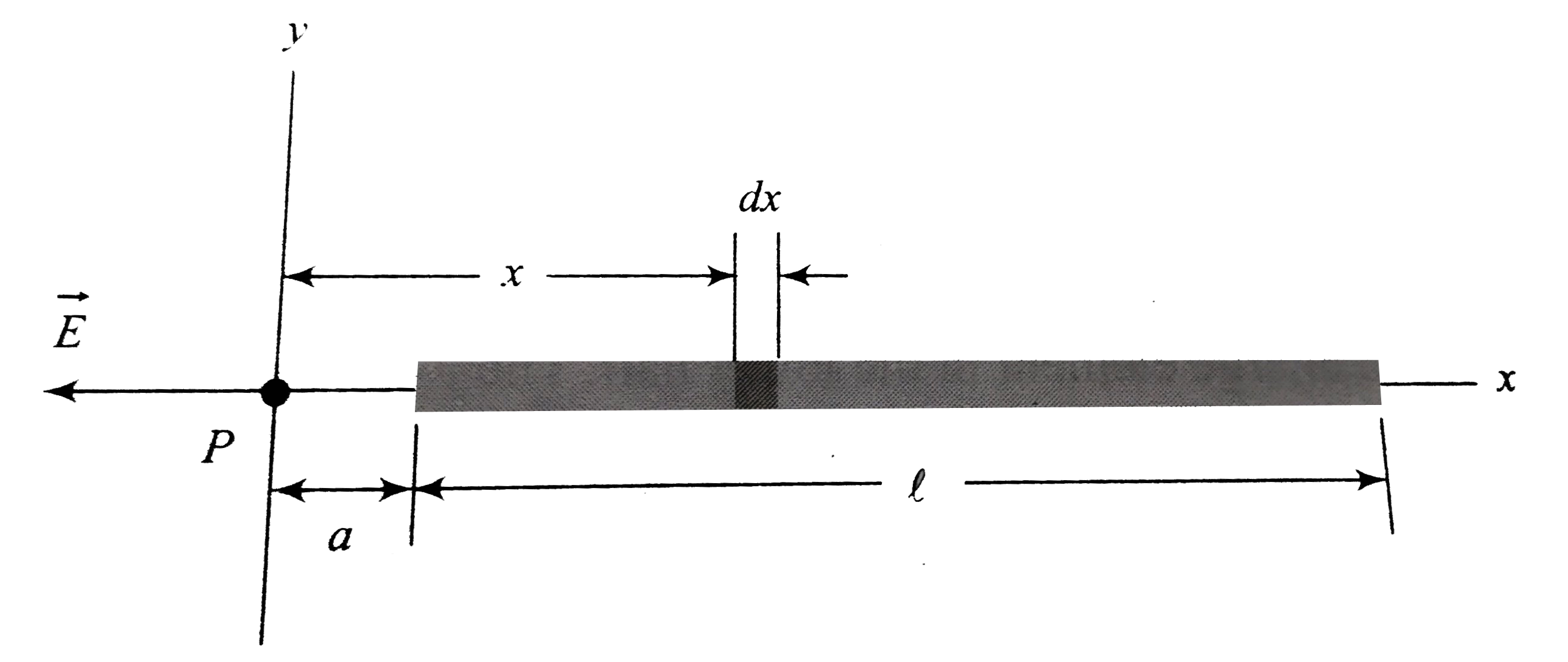A non-conducting semi-infinite rod lies along the x-axis as shown in the Figure one end at x=0 and the other at x=-infinity. The rod has charge uniformly distributed along its length with a linear density λ. What is the x-component of the electric field Ex at a point P located a distance y above the end of the rod ?
From the figure we see that where I used dQ = λdx and sinθ = -x/r with r2 = x2 + y2.
Related Solutions
A positively charged rod lies along X-axis in such a manner that one end of the rod is at the origin and the other end at . The linear charge density for the rod is . Electric field intensity at x =a is
View SolutionA rod of length 'l' is placed along x-axis. One of its ends is at the origin. The rod has a non-uniform charge density lambda= a, a being a positive constant. Electric potential at P as shown in the figure is -
View SolutionA rod of length 'l' is placed along x-axis. One of its ends is at the origin. The rod has a non-uniform charge density lambda= a, a being a positive constant. Electric potential at P as shown in the figure is -
View SolutionA non–uniform thin rod of length L is placed along x-axis as such its one of ends at the origin. The linear mass density of rod is lambda=lambda_(0)x . The distance of centre of mass of rod from the origin is :
View SolutionA non–uniform thin rod of length L is placed along x-axis as such its one of ends at the origin. The linear mass density of rod is lambda=lambda_(0)x . The distance of centre of mass of rod from the origin is :
View SolutionA non-uniform thin rod of length L is placed along X-axis such as one of its ends is at the origin. The linear mass density of rod is l=lambda_(0)x . The distance of centre of mass of rod from the origin is
View SolutionA rod of length l is placed along the x-axis. One end of it is at the origin. uneven charge density in the rod lambda = a/x Yes, a is a positive constant. As shown in the figure, the electric potential at P is:
View SolutionA rod of length l is placed along the x-axis. One end of it is at the origin. uneven charge density in the rod lamda = a/x Yes, a is a positive constant. As shown in the figure, the electric potential at P is:
View SolutionA rod of length l, has a uniform positive charge per unit length and a total charge Q. calculate the electric field at a point P located along the long axis of the rod and at a distance a from one end

View SolutionA non-uniform thin rod of length L is placed along X-axis such as one of its ends is at the origin. The linear mass density of rod is l =lamda_0x The distance of centre of mass of rod from- the origin is
View Solutionएक आवेश Q लम्बाई L की छड़ AB के अनुदिश एकसमान रूप से वितरित है जैसा कि चित्र में दिखाया गया है एक बिन्दु O पर जो सिरे से L दूरी पर स्थित है पर वैद्युत विभव है-

View SolutionA rod of length l is placed along x - axis. One of its ends is at the origin. The rod has a non - uniform charge density , a being a positive constant. The electric potential at the point P (origin) as shown in the figure is

View SolutionA rod of length l is placed along x - axis. One of its ends is at the origin. The rod has a non - uniform charge density lambda=(a)/(x) , a being a positive constant. The electric potential at the point P (origin) as shown in the figure is
View SolutionThere is a conducting rod of length 2L that lies along x-axis from . If rod moves with velocity in the magnetic field, then induced EMF between ends of rod is
View SolutionA point charge 4 is situated at a distance r on axis from one end of a thin conducting rod of length L having a charge Q (Uniformly distributed along its length). "The magnitude of electric force between the two is ________.
View SolutionA rod of length l, has a uniform positive charge per unit length and a total charge Q. calculate the electric foeld at a point P located along the long axis of the rod and at a distance a from one end

View SolutionA rod lies along the x-axis with one end at the origin and the other at x rarr oo . It carries a uniform charge lambda C/m. The electric field at the point x = -a on the axis will be
View SolutionA rod lies along the X-axis with one end at the origin and the other at x rarr oo . It carries a uniform charge lambda Cm^(-1) . The electric field at the point x=-a on the axis will be
View SolutionA rod lies along the X-axis with one end at the origin and the other at x rarr oo . It carries a uniform charge lambda Cm^(-1) . The electric field at the point x=-a on the axis will be
View SolutionA uniformly charged rod whose length is 4cm and linear charge density lambda=30 mu C//m is, The x-component of the electric field at point P will be: -
View Solution